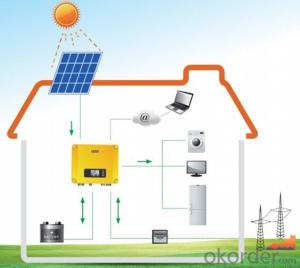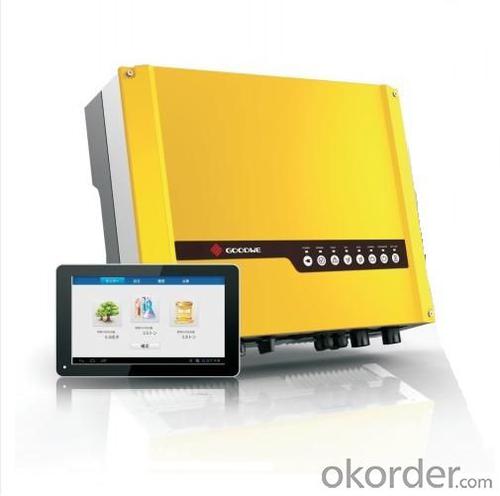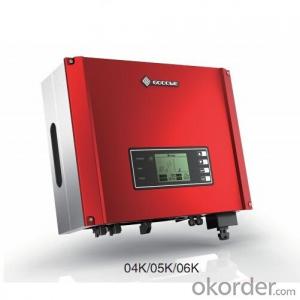MPP Solar Inverter 48V Hybrid Solar Inverter GW3648D-ES
OKorder Service Pledge
OKorder Financial Service
You Might Also Like
GW3648D-ES series bidirectional energy-storage inverter is applicable for both on-grid and off-grid PV systems and can control the flow of energy hybrid with its working situation able to be switched automatically or manually. During the day time, the PV plant generates electricity which can be provided to the loads, fed into the grids or charged the battery. The power stored can be released when the loads require it during the night. Additionally, power grid can also charge the storage devices via the inverter..
Datasheet

- Q: Can a solar inverter be connected to a battery storage system?
- Yes, a solar inverter can be connected to a battery storage system. This allows excess solar energy generated during the day to be stored in the batteries and used later when there is no sunlight, providing a reliable source of power.
- Q: What is the role of reactive power control in a solar inverter?
- The role of reactive power control in a solar inverter is to manage and optimize the flow of reactive power between the solar PV system and the grid. This control allows the inverter to regulate the power factor, which is the ratio of real power to apparent power, ensuring that the system operates efficiently and in compliance with grid requirements. By adjusting the reactive power output, the inverter can compensate for voltage fluctuations and stabilize the grid, improving the overall performance and reliability of the solar power generation system.
- Q: Can a solar inverter be used in a solar-powered irrigation system?
- Yes, a solar inverter can be used in a solar-powered irrigation system. The solar inverter is responsible for converting the DC (direct current) power generated by the solar panels into AC (alternating current) power that is required for operating the irrigation system. This allows the solar panels to provide the necessary energy to power the irrigation system, making it an efficient and sustainable solution.
- Q: What is the role of a solar inverter in a solar power system?
- The role of a solar inverter in a solar power system is to convert the direct current (DC) electricity generated by the solar panels into alternating current (AC) electricity that can be used to power appliances and devices in homes or businesses. It also regulates and optimizes the flow of electricity to ensure maximum efficiency and safety in the solar power system.
- Q: How is the output voltage of a solar inverter regulated?
- The output voltage of a solar inverter is regulated through the use of control circuitry and power electronics components. These components monitor the input voltage from the solar panels and adjust the output voltage to meet the desired specifications. The control circuitry ensures that the output voltage remains stable and within the required range, even when there are fluctuations in the input voltage or varying load conditions.
- Q: How does a solar inverter handle frequency variations in the grid?
- A solar inverter handles frequency variations in the grid through its built-in control mechanisms. It continuously monitors the frequency of the grid and adjusts its own output accordingly to match the grid frequency. This ensures that the solar inverter remains synchronized with the grid and allows for seamless power transfer between the two.
- Q: How does a solar inverter handle power export limitations imposed by the grid?
- A solar inverter handles power export limitations imposed by the grid through various mechanisms. Firstly, it monitors the grid's voltage and frequency, ensuring it remains within acceptable limits. If the grid voltage or frequency goes beyond the defined range, the inverter automatically disconnects from the grid to prevent any damage. Additionally, the inverter employs power control algorithms to regulate the amount of power being exported to the grid. When the grid imposes limitations on power export, the inverter adjusts its power output accordingly to comply with the restrictions. This can be achieved by reducing the solar system's overall power generation or by dynamically adjusting the inverter's operating parameters. Some advanced inverters also offer functionalities like reactive power control, which enables them to actively manage the power factor and stabilize the grid's voltage. This helps in maintaining grid stability and mitigating any issues related to power export limitations. Overall, a solar inverter plays a crucial role in ensuring compliance with grid-imposed power export limitations by continuously monitoring the grid parameters and adjusting its power output accordingly.
- Q: How is the size of a solar inverter determined?
- The size of a solar inverter is determined based on the maximum power output of the solar panels connected to it. It should match or exceed the total capacity of the solar panels to ensure optimal performance and avoid any power limitations.
- Q: How does a solar inverter affect the overall energy consumption of a property?
- A solar inverter affects the overall energy consumption of a property by converting the direct current (DC) electricity produced by solar panels into alternating current (AC) electricity that can be used to power electrical appliances and equipment in the property. It ensures that the electricity generated by the solar panels is compatible with the property's electrical system, reducing the dependence on grid-supplied electricity. By efficiently converting solar energy into usable electricity, a solar inverter helps to lower the property's energy consumption from traditional sources and can potentially result in energy cost savings.
- Q: What is the maximum AC power output of a solar inverter?
- The maximum AC power output of a solar inverter depends on its size and capacity. Generally, residential solar inverters have a maximum AC power output ranging from 1 kilowatt (kW) to 10 kW, while larger commercial or utility-scale inverters can have outputs exceeding 1 megawatt (MW).
Send your message to us
MPP Solar Inverter 48V Hybrid Solar Inverter GW3648D-ES
OKorder Service Pledge
OKorder Financial Service
Similar products
Hot products
Hot Searches
Related keywords
























